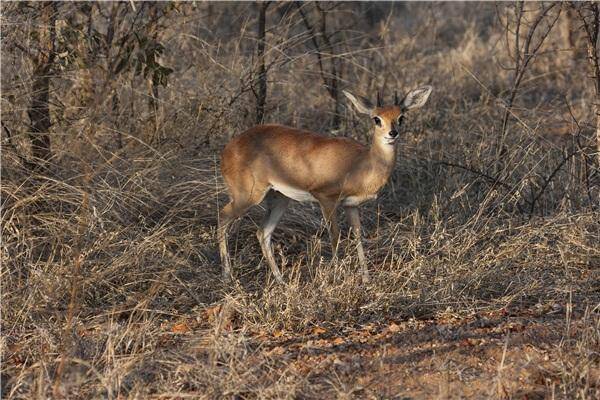Raphicerus campestris
IUCN
LCBasic Information
Scientific classification
- name:Raphicerus campestris
- Scientific Name:Raphicerus campestris
- Outline:Ungulata
- Family:Artiodactyla Bovidae Stag
Vital signs
- length:70-95cm
- Weight:7-16kg
- lifetime:10-12years
Feature
There is a circle of white hair around the big eyes, and a thin black triangle
Distribution and Habitat
Found in Angola, Botswana, Eswatini, Kenya, Mozambique, Namibia, South Africa, Tanzania, Zambia, and Zimbabwe.
Extinct: Lesotho.
The distribution of the lesser steenbok is discontinuous, with one population in East Africa (southern Kenya, northern and central Tanzania) and a larger population in southern Africa, the two separated into isolated groups in central Zambia, Malawi (no records), and the tall woodlands of northern Mozambique. In southern Africa, its range extends from southern Angola and western Zambia to most of Namibia (except in the arid coastal areas), throughout Botswana, most of Zimbabwe, southern Mozambique, and most of South Africa (only southern and southeastern KwaZulu-Natal and the adjacent Eastern Cape Province are absent). While their distribution in southern Africa is largely unchanged, in East Africa they are no longer found in Uganda, where their habitat has become agricultural.
Found in open grasslands where tree cover is not very dense across much o
Appearance
The steenbok is a small animal, with a head-body length of 70-95 cm, a shoulder height of 45-60 cm, a tail length of 5-10 cm, and a weight of 7-16 kg. The legs are very long and the animal stands upright. The coat is a light golden brown, but there is some variation between individuals, with some being reddish and others being grayish. The underparts are white. The fur rarely has noticeable spots. There is a ring of fine white hair around the large eyes, and a thin black triangle that tapers from the nose upwards. The ears are very large. Only males have horns, which are very erect, straight and pointed, and about 7-19 cm long.
Details
Raphicerus campestris (Steenbok in English, Steenbok in French, Steenbok in South Africa, Steinbockchen in German) has 4 subspecies.

The common duiker (Sylvicapra grimmia) is similar in size and color to the sylvicapra grimmia, but is usually more whitish (grey) in appearance. The common duiker usually has a black radial flame pattern on its face that runs from the top of the head to the nose; it also has smaller, narrower ears. Ourebia ourebi is similar to the lesser steenbok in color and shape, but is larger and thinner. There is a distinct black patch at the base of the ears, and no black on the front of the face.
The lesser steenbok is most active during the day, although they may seek shelter in the shade when midday temperatures peak. The species is usually solitary, but has a stable pair, the two sexes usually stay apart and only come together for breeding. When breeding they share a plot of land of about 4-100 hectares in size. This territory is marked by dung piles by both sexes. When threatened, the lesser steenbok will lie still on the ground to avoid danger. If the threat continues to approach, they will quickly run a short distance away and then try to hide again. Aardvark holes can be used as shelter.
The steenbok is a herbivore, eating mainly leaves from shrubs and trees, as well as fruits and grasses. Predators include all carnivores: wild cats (large and small) and pythons. Young steenboks may be hunted by smaller carnivores, such as jackals, birds of prey, monitor lizards, and baboons.

The young antelope can breed all year round. The gestation period of the female antelope is 170 days, and each calf is born. The weaning period is 3 months. The young antelope can stand and walk a few minutes after birth. However, the newborn antelope is usually hidden by its mother for several weeks before it begins to follow her around. Females reach sexual maturity at 6-7 months, and males begin to mature at about 9 months. Lifespan 10-12 years.
The total population of the lesser steenbok is estimated to be over 600,000, but this is an underestimate. Aerial surveys underestimate populations, but ground surveys in areas where the species is common have yielded density estimates of 0.3-1.0 individuals per square kilometer (East 1999). In general, there are no reliable estimates of population density for the lesser steenbok, as census methods are too unreliable for this cryptic species. The species has no major threats. However, the lesser steenbok is locally vulnerable to predation by domestic dogs and herders, who often capture and kill young steenboks, especially when they are found alone in cover.
Listed in the IUCN Red List of Threatened Species (IUCN) 2016 ver3.1 - Least Concern (LC).
Protect wild animals and stop eating game.
Maintaining ecological balance is everyone's responsibility!








